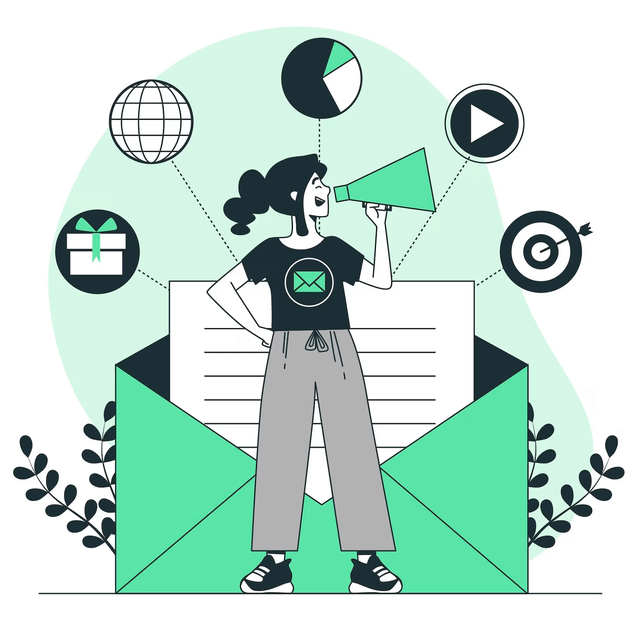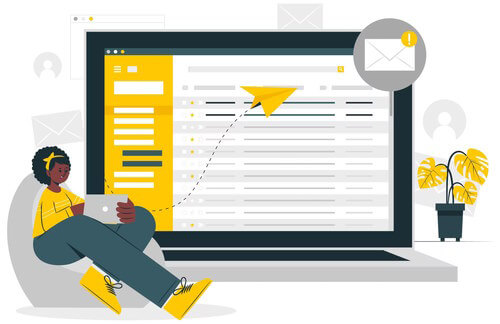We all get emails from businesses we’ve dealt with, some can be useful, some are just annoying. Creating a great email marketing strategy can be a huge benefit to your marketing efforts and here we’ll look at how you can achieve this.

As a business owner, you’re constantly looking for new ways to reach your target audience and drive sales. Email marketing is a powerful tool that can help you achieve both of these goals. Email marketing involves sending targeted, personalized emails to your subscribers with the goal of building relationships, generating leads, and increasing sales.
Email marketing has one of the highest returns on investment (ROI) of any marketing channel. In fact, for every $1 spent on email marketing, businesses can expect an average return of $42 (DMA, 2019). Additionally, email marketing allows you to reach your audience directly, without the distractions of social media or other channels. By building a targeted email list, you can ensure that your message is being delivered to the right people at the right time.
Introduction To Email Marketing
How Does Email Marketing Work?

Email marketing works by building an email list of subscribers who have opted in to receive communications from your business. Once you have a list, you can create and send targeted emails to your subscribers. These emails can be personalized with the subscriber’s name, location, and other information to make them more engaging and relevant.
To create an effective email marketing campaign, you’ll need to have a clear goal in mind, such as driving sales or building brand awareness. You’ll also need to create compelling content that resonates with your audience and encourages them to take action. This could be as simple as a discount code or a call to action to visit your website.
Once you’ve created your email, you’ll need to choose a platform to send it from. There are many email marketing platforms available, including Mailchimp, Klayvio, and OmniSend. These platforms allow you to create, send, and track your emails, as well as manage your subscriber list.
How To Get Started
If you’re working with us at Revelate, the first step is to define your goals and objectives. What do you want to achieve with your email marketing campaign? If you’re not sure what your goals should be we can run through several different options that we think will work best for you. Once you have that figured out, we will help you build your email list, create engaging content, and send emails to your subscribers.
We will also help you choose the right platform for your business and provide guidance on best practices for email marketing. While the 3 services we’ve previously mentioned have been the most effective for our clients we have worked with many other services as well. Once the campaign is launched we’ll also provide reporting and analytics to help you track the success of your campaigns.
Building An Email List
You may already have a list of emails that you can use for your email marketing campaign, but we’ll also help you continue building out your list so that you are constantly adding new subscribers. Building an email list is a crucial part of email marketing. Without adding to your list the number of subscribers will go down as people move, enter a different stage of life where your product may not be useful to them or any other reason. There are many ways to collect email addresses and grow your list, including:
- Offering a free resource in exchange for an email address
- Hosting a giveaway or contest that requires an email address to enter
- Including a sign-up form on your website or social media pages
- Asking customers for their email address at the point of sale
- Offering a discount for subscribers
Email Marketing Tips
Segmentation

One of the biggest advantages of email marketing is the ability to personalize your messages for different groups of subscribers. By segmenting your audience based on their demographics, behaviors, interests, or preferences, you can create more targeted and relevant emails that resonate with each group.
To segment your audience, start by analyzing the data you have collected on your subscribers. Look for patterns and trends that can help you divide your list into different segments. For example, you could segment your list based on their location, age, gender, purchase history, engagement level, or whether they are corporate or consumer customers.
Once you have identified your segments, you can create customized content that speaks directly to each group’s needs and interests. For instance, you can send targeted promotions or product recommendations to customers who have previously made a purchase from your website, or you can send different versions of your newsletter to subscribers who have shown an interest in specific topics.
Segmenting your audience not only increases the relevancy of your emails but also helps you achieve better engagement rates and conversion rates. According to a report by Econsultancy, targeted emails have an open rate of 22.2% compared to 15.8% for non-targeted emails.
Overall, segmenting your audience is an effective way to improve the performance of your email campaigns and build stronger relationships with your subscribers. By showing that you understand their needs and preferences, you can increase their trust and loyalty to your brand.
Personalisation
Email marketing is an incredibly powerful tool for reaching out to your audience and building strong relationships with them. But one way to take your email campaigns to the next level is to personalize your messages to your subscribers. According to a study by Epsilon, personalized emails have an open rate that is 29% higher than non-personalized emails. Here are some tips on how to use personalization in your email marketing campaigns:
- Use their name: Personalization starts with the basics. Use your subscribers’ first names in the subject line and opening of the email to make it feel more personal and engaging.
- Use their location: You can use your subscribers’ location to personalize the content of your email. For example, you can include a weather report or news about events happening in their area.
- Use their past behavior: You can personalize your email based on your subscribers’ past behavior, such as the pages they’ve visited on your website or the products they’ve purchased. This can help you recommend products or services that are more relevant to them.
- Use their preferences: You can also personalize your email based on your subscribers’ preferences, such as the topics they’re interested in or the types of content they prefer.
By personalizing your email campaigns, you can increase engagement and conversions, and ultimately build stronger relationships with your subscribers.
Effective Calls To Action
The call-to-action (CTA) is one of the most important elements of your email marketing campaign. It’s the part of the email that encourages your subscribers to take action, whether that’s clicking on a link, making a purchase, or filling out a form. Here are some best practices for including a clear and compelling call-to-action in your emails:
- Use action-oriented language: Use language that encourages your subscribers to take action. Use verbs such as “click,” “register,” or “buy now.”
- Make it stand out: Make sure your CTA stands out visually. Use contrasting colors, bold text, or buttons to make it more prominent.
- Keep it simple: Keep your CTA short and simple. Don’t use too many words or complicated language.
- Place it above the fold: Make sure your CTA is placed near the top of your email, so your subscribers don’t have to scroll down to find it.
- Create a sense of urgency: Use language that creates a sense of urgency, such as “limited time offer” or “last chance.”
By following these best practices, you can create a clear and compelling call-to-action that encourages your subscribers to take action and ultimately drive conversions.
Analysis & Continuous Improvement
Tracking and analyzing your email performance is essential for measuring the success of your email marketing campaigns. By understanding how your subscribers are interacting with your emails, you can make informed decisions about how to improve your campaigns. Here are some key metrics you should be tracking:
- Open rate: The percentage of subscribers who open your email.
- Click-through rate (CTR): The percentage of subscribers who click on a link in your email.
- Conversion rate: The percentage of subscribers who take the desired action, such as making a purchase or filling out a form.
- Bounce rate: The percentage of emails that are undeliverable.
- Unsubscribe rate: The percentage of subscribers who unsubscribe from your email list.
By tracking these metrics, you can identify what’s working well in your campaigns and where you can improve. By constantly using the information from your analytics you can improve the quality and effectiveness of your emails.
Privacy
GDPR and Irish Law

Email marketing is highly regulated to ensure that consumers are protected from spam and unwanted emails. In Ireland, businesses must comply with the General Data Protection Regulation (GDPR) when collecting and using personal data for email marketing purposes. This regulation sets strict rules about the collection, storage, and use of personal data, including email addresses.
When collecting email addresses, businesses must obtain explicit consent from subscribers to receive marketing emails. This means that they must opt-in to receive emails, and businesses cannot assume consent. Additionally, businesses must provide a clear and easy opt-out mechanism for subscribers to unsubscribe from their email list at any time.
Businesses must also ensure that their email content is compliant with GDPR rules. This means that they cannot use misleading subject lines, must clearly identify themselves as the sender, and must provide an easy way for subscribers to identify the purpose of the email. Businesses must also be transparent about the data they collect and how they will use it.
Violating GDPR regulations can result in significant fines and damage to a business’s reputation. Therefore, it is important for businesses to work with a knowledgeable email marketing agency that understands the regulations and can help them comply with GDPR rules.
Conclusion
Email marketing is a powerful tool for small businesses to reach and engage with their audience. By sending targeted and personalized emails, businesses can increase customer loyalty, drive conversions, and build long-term relationships with their subscribers. It is important to work with a professional agency to help you develop a successful email marketing strategy that aligns with your business goals and complies with GDPR regulations. At Revelate we’ve been running email campaigns for more than 10 years with great success for our customers.
Remember, email marketing is not a one-time effort. Building relationships with your subscribers takes time and effort. By consistently sending valuable and relevant emails to your subscribers, you can establish trust and loyalty that will benefit your business in the long run.

